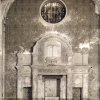The 10th November 1938
The assassination of the German embassy councilor Ernst vom Rath in Paris by the seventeen-year-old Jew Herschel Grynszpan on 7 November 1938 was a welcome occasion for Hitler to mobilize the long-planned "spontaneous folk anger" against Jewish god-houses, shops, apartments and people.
The pogrom in St. Pölten ran according to the same basic pattern as in other cities. A crowd gathered in front of the synagogue. A hard core, allegedly under the leadership of a SS leader from Krems, began the destruction, which finally took part in numerous attendants. The silent majority found "the right direction and the enemy images of the pogrom, but not all its forms". (Gerhard Botz)
In the city and its surroundings, a total of 137 Jews between the ages of 18 and 60 were arrested, among them the brothers Rudolf and Hermann Gelb. They were taken to Vienna and many of them to the Dachau concentration camp. Paradoxically, the imprisonment in Dachau saved many Jews because they were released by issuing a visa and the requirement to leave by the end of the year.
The devastation of the synagogue
„In the middle of a German city - and that is Sankt Pölten, is not it? - there rises up an Oriental building, curled characters "front" its front, and a star rises on the dome, which we like to dispense with in our sky. If this building once stands without sense and purpose, and soon (it is clear, here the Ostmark is indicative), then will it make way for a "representative" building? If we succeeded in cleaning the business life in our city from strangers, the external phenomena must also follow.“ This unrulled invitation to the destruction of the St. Pölten Synagogue was already written by the "St. Pöltner Anzeiger" on 5 November 1938.



